[Retracted] Application and Analysis of Artificial Intelligence in College Students’ Career Planning and Employment and Entrepreneurship Information Recommendation
Abstract
With the arrival of graduation season, the number of graduates is expanding every year, and the employment rate of college students has become one of the data that colleges and universities pay attention to. To improve the employment rate of college students, we should first educate each college student in career planning, so that they can clearly understand their own positioning and future development direction. Career planning can guide students to understand their jobs and analyze their professional fields. Faced with massive employment information, it is also a big problem for college students to search and choose information. In this paper, the personalized recommendation system for entrepreneurship is described, and the basic principles of information recommendation are described. The basic information and personal interest points of college students are represented by feature vectors, which provide a favorable theoretical support for college students’ career planning and employment and entrepreneurship information recommendation. An information recommendation model under deep learning is formed. Finally, the performance of the model under the traditional algorithm and the optimized information recommendation model is evaluated, and the satisfaction of users to this system is scored so as to provide a convenient and quick information recommendation system for college students, thus indirectly improving the employment rate of graduates and providing corresponding solutions to the problem of difficult employment.
1. Introduction
In this era of rapid information development, the acquisition of resources is convenient and fast. College students’ career planning is particularly important for their future development, which is a clear plan for their future. College students choose the learning resources and knowledge data they need to plan their future development on the Internet and make a preliminary design of themselves by using the algorithm recommended by the platform [1]. From the perspective of the Internet, this paper analyzes how college students should plan their careers and know themselves correctly from what aspects [2]. The teaching mode is to take online teaching data to reflect on offline teaching, stimulate college students’ awareness of independent career development, set teaching content according to the law of students’ growth process, and carry out teaching activities aiming at cultivating students’ practical ability in the process of exploration [3]. According to the online recruitment information, this paper analyzes the feasibility of career planning of Chinese college students. Taking the major of human resource management as an example, this paper studies the determination of career development path, job quality requirements, and career planning stage of Chinese college students and uses dynamic network recruitment information to adopt the rolling planning method to plan college career [4]. Career planning education strengthens the ideological and political education of college students and enhances the effectiveness, affinity, and appeal of ideological and political education. Finally, it discusses the countermeasures of this education to college students’ career planning [5]. With the continuous expansion of e-commerce, the traditional recommendation system can no longer meet the needs of current data processing. Combined with the recommendation algorithm of big data, a personalized recommendation system of e-commerce platform is constructed [6]. Data collection and processing are carried out in distance education, and gesture recognition of virtual reality is used to recommend educational information in class [7]. On the social platform, the influence of users’ comments on the surrounding environment and active screening and recommendation of information are the basic user activities and services of the social software [8]. In the recommendation of students’ personalized problems in the field of education, this paper puts forward a recommendation algorithm of tacit knowledge points and verifies whether the algorithm is reliable [9]. As for the increasing information and suggestions in the investment market, the portfolio model is optimized by empirical analysis according to different fuzzy information [10]. While enhancing situational awareness, it also brings many challenges to the recommendation of battlefield situation information. In the sorting stage, the situation information in the candidate set is accurately scored and sorted, and finally, the situation information with higher scores is recommended to the commander [11]. In the collaborative filtering algorithm model, users can quickly collect personalized information of users with high accuracy, which can provide a quick way for users to retrieve information [12]. In the aspect of web page design and smart phone, the system of tourism information recommendation needs to aim at the real needs of users, carry out intelligent data screening, and provide the information they want according to their preferences [13]. Label labeling is also based on the recommendation algorithm of the system, which constructs a synonymous label set for collecting synonymous labels under the definition classification, which is the result of applying the cluster seepage method to the existing resources of users [14]. The development of Internet is also important for farmers to obtain information resources. Farmers can plant grains according to accurate agricultural information to meet people’s needs [15]. When recommending information, there will be a lot of mixed, fuzzy, and cross information, which will be fused according to their similarity and recommended to users [16]. There are many incomplete domains in migration learning that will be used in information recommendation systems [17]. Analyze users’ information access history records, extract their whereabouts, label them according to semantic means, and finally search users for information [18]. For the generation of massive data information in the bus card, a comfortable bus route can be recommended to passengers according to their needs. The bus data card can calculate the waiting time, congestion time, and travel time between different bus stops on different bus lines at different times [19]. In the mobile environment, the group system recommendation is carried out considering the preferences of group users, and the recommendation system can also be used for restaurant recommendation according to the preferences of users themselves [20]. On social software, the platform will also recommend people you may know according to your personal information and contacts and recommend friends among users [21]. In business activities, the personalized recommendation system also has an important application value and carries out personalized recommendation of mobile business methods [22]. Between the system and users, a system simulation model of personalized information recommendation is established, the effectiveness of the model and the sensitivity of main influencing parameters are analyzed, and the characteristics and mechanism of information recommendation between the system and users are revealed [23]. Users interact with tags. Based on the tensor decomposition method of the matrix model, especially the pyramid decomposition method, aiming at the high computational complexity of the TD model, a pairwise interactive tensor decomposition method is proposed to optimize it [24]. According to an abstract conceptual method, human preferences are recommended for new information. The recommended items are selected by using conceptual ideas, which is the user’s impression of the items inferred by using label data of free classification [25].
2. Personalized Recommendation System
2.1. Brief Introduction of the Personalized Recommendation System
The personalized recommendation system has become an important tool to obtain information in this era of information crossing. It screens users’ browsing records and personal information according to big data technology to predict products and information that users may like. This can greatly increase the consumption rate and click rate of customers. Personalized information recommendation needs three parts. The first step is to collect and process the information, analyze the information, and finally use the recommendation algorithm to recommend information to users. The process is shown in Figure 1.
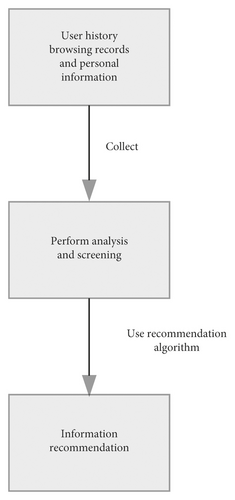
2.2. Types of Information Recommendation
There are many kinds of information recommendation contents, such as entertainment, literature, and combination. Entertainment information recommendation mainly integrates information according to the praise rate and comment rate of entertainment videos that users often click on and establishes a user preference model to recommend videos to users, which also increases users’ liking for apps. Literary information recommendation mainly analyzes information according to the news content and personal information that users usually watch and recommends knowledge information to users according to the analysis of news viewing content of different ages, which can accurately push the news that users want to know and the knowledge sources they want to learn. Combined information recommendation is complex, the information from different sources of users is analyzed and screened, and finally, information integration is carried out through the personalized recommendation algorithm to form different information recommendation models for each user. The information sources of combined information recommendation are more complex, and various algorithms are used to recommend so as to improve the accuracy of user preference information. The general flow of information recommendation content is shown in Figure 2.
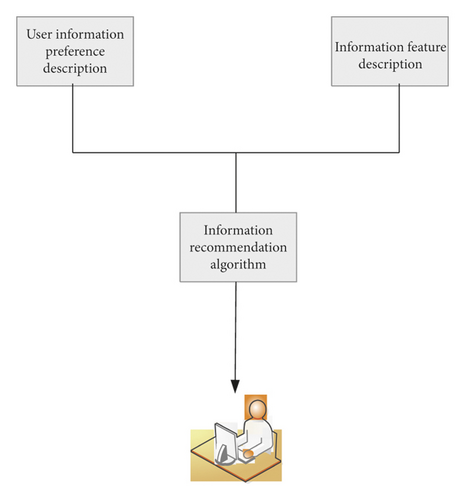
3. Information Recommendation Algorithms
3.1. Employment Recommendation Algorithm for College Students
Collect and filter the user’s information, the information content comes from different directions, and translate the information content into text information, that is, the content recommendation process is as follows.
Step 1. Transform the content. Each feature point of content is converted into vector points of different dimensions of the space vector, assuming that the text information after content conversion is i, xi is content feature point, and yi is weight. The expression for content i is
The feature points of the content are represented by vectors:
Step 2. Nw is the feature index, and the similarity relationship between content feature points is calculated. Then, different users have different preference models, and the expression is as follows:
Calculate the similarity of each similarity point of the content:
Step 3. Generate information recommendation results. The information with the highest similarity is integrated and recommended to users.
In order to realize the career planning and employment and entrepreneurship information recommendation of college students, the information distribution model is constructed. Collect personal information from universities and output data sequences of information characteristics:
Integrate the characteristic points of college students’ personal information, that is, the expression of characteristic quantity is as follows:
The sampling model of characteristic points of college students’ personal information:
In the information feature point sampling model, k is the amount of employment information and q is the employment intention index.
Personal information similarities of college students’ employment intentions:
The similarity of information recommendation index between different college students is quantified by standard, and the formula is as follows:
Employment recommendation information is mainly matched according to the interest and hobbies of college students. By correlating the information of college students’ interests and hobbies, the feature extraction model of college students’ interest points is obtained:
The distribution expression of the spatial set of information characteristics of college students’ job allocation in different fields:
According to the interest and hobbies of college students, information screening is carried out to establish ambiguity functions related to their interest:
Construct the distribution model of college students' employment interest characteristics:
3.2. Career Planning Algorithm for College Students
4. Experimental Analyses
4.1. Simulation Experiment
According to the employment data statistics of fresh graduates in 2022, the traditional algorithm model and deep learning algorithm are used to match the interest characteristics of college students, and their accuracy and time-cost calculated by the employment recommendation model are compared. As shown in Figures 3 and 4, the relevant parameters are set as follows: the feature scale dataset of user interest points is Q = 500, the fuzzy matching coefficients of interest points are c1 = 0.34 and c2 = 0.32, the distribution coefficient of personalized preference features is cr = 2, the prediction coefficient of recommendation model is μ1 = μ2 = 0.01, and the total iteration times are 140.
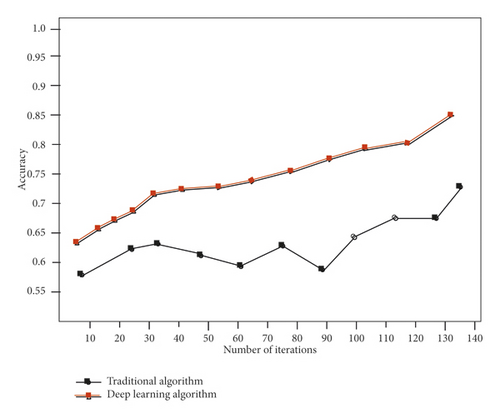
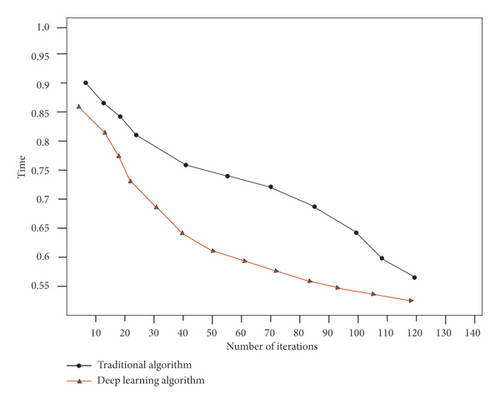
4.2. Functional Testing
This system is mainly aimed at college students’ career planning customization and employment information recommendation services. The following is a test of the functions of each module for the employment information of college students to test whether these functions can be accurately realized and how the running results are. The statistical information is shown in Table 1.
| Test model | Method | Judgment criterion |
|---|---|---|
| Register/login | Perform multiple registration/login tests | Can you succeed? |
| Modify personal information | Submit after adding/modifying information | Is personal information in the database? |
| Online recommendation | Modify personal information viewing results | Can you update it in real time? |
| Satisfaction degree of recommended information | Satisfaction rating | Can you score? |
4.3. Performance Testing
Excellent performance is necessary for any information recommendation system. If the performance of the system is too poor, users will have a bad experience, and users will also reduce the use of the recommendation system. Four nodes of the recommendation system are tested. The total number of employment information databases is about 2,000. The relationship between recommendation information response and the number of nodes and employment information is shown in Figures 5 and 6.
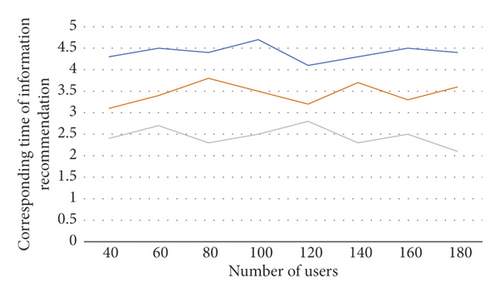
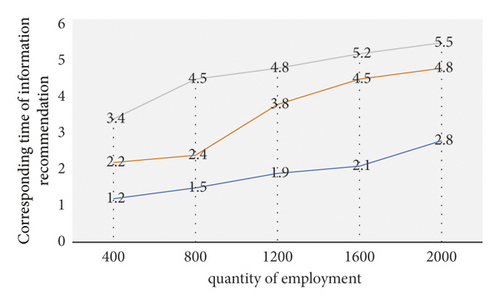
Statistics of time and cost information of recommendation information model is shown in Table 2.
| Number of nodes | Number of users | |||||||
|---|---|---|---|---|---|---|---|---|
| 40 | 60 | 80 | 100 | 120 | 140 | 160 | 180 | |
| 2 | 4.3 | 4.5 | 4.4 | 4.7 | 4.1 | 4.3 | 4.5 | 4.4 |
| 3 | 3.1 | 3.4 | 3.8 | 3.5 | 3.2 | 3.7 | 3.3 | 3.6 |
| 4 | 2.4 | 2.7 | 2.3 | 2.5 | 2.8 | 2.3 | 3.6 | 2.1 |
The time-cost of recommendation information response and the number of employment information are counted as shown in Table 3.
| Number of users | Amount of employment information | ||||
|---|---|---|---|---|---|
| 400 | 800 | 1200 | 1600 | 2000 | |
| 100 | 1.2 | 1.5 | 1.9 | 2.1 | 2.8 |
| 200 | 2.2 | 2.4 | 3.8 | 4.5 | 4.8 |
| 300 | 3.4 | 4.5 | 4.8 | 5.2 | 5.5 |
4.4. Contrast Experiment
Information screening and fusion under big data analysis, in order to compare the information recommendation system under big data analysis in many aspects, is employment information recommendation and career planning under artificial intelligence better? We make a comprehensive performance comparison of the employment information recommendation model, and the data are shown in Table 4 and Figure 7.
| Model | Accuracy (%) | Recall (%) | F1 (%) | MAE (%) | ROC (%) |
|---|---|---|---|---|---|
| BP | 98.99 | 89.97 | 78.25 | 10.87 | 87.63 |
| Traditional algorithm | 76.84 | 65.43 | 54.72 | 53.48 | 75.49 |
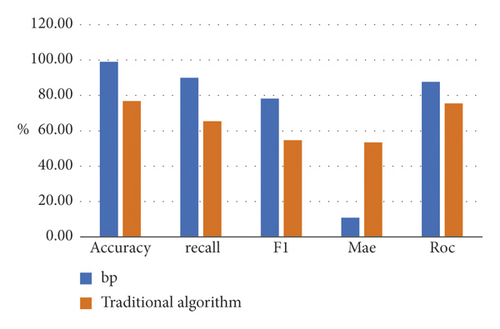
In order to intuitively see the applicability of the employment recommendation system to college students, we systematically score the per capita satisfaction of college students who have used the information recommendation system and compare the recommendation system using the algorithm model under deep learning with the traditional algorithm model, respectively. The experimental data are shown in Table 5.
| Scoring point | Model | |
|---|---|---|
| Deep learning model (%) | Traditional model (%) | |
| 5 scoring points per capita | 3.7 | 65.6 |
| 10 scoring points per capita | 77.9 | 23.7 |
| 15 scoring points per capita | 18.4 | 10.7 |
Users carry out quality analysis and research on the information recommendation scoring points of the system and its evaluation standard MAE. The correlation between the per capita scoring points and MAE performance evaluation indicators is shown in Figure 8.
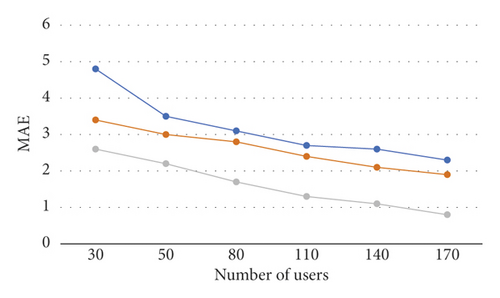
5. Conclusion
- (1)
The starting point of employment and entrepreneurship information recommendation algorithm is to build the recommendation strategy algorithm model through the basic personal information and interest feature points of users
- (2)
Combined with the information recommendation model under deep learning, the information and users’ needs can achieve an optimal matching mechanism, which greatly improves the accuracy of information recommendation and forms a good information retrieval experience for users
- (3)
Taking the corresponding time of the model as the performance evaluation index of the information recommendation system, the optimized algorithm model can improve the accuracy of information recommendation
- (4)
According to the user satisfaction score and the MAE value of the model, we can further see the feasibility of the information recommendation model for employment and entrepreneurship information recommendation and career planning
Conflicts of Interest
The authors declare that they have no conflicts of interest.
Open Research
Data Availability
The data used to support the findings of this study are available from the corresponding author upon request.




